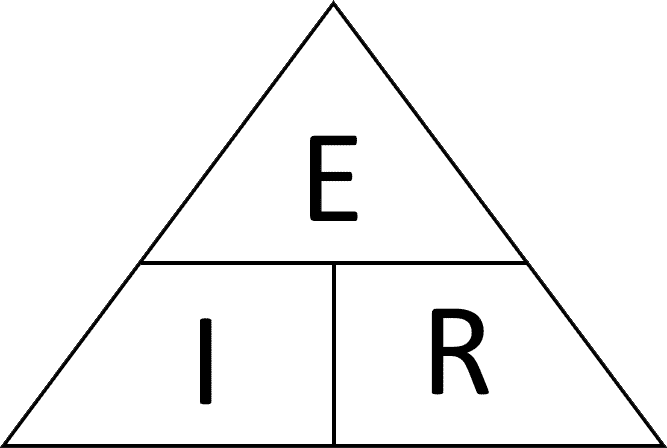In this guide:
The most fundamental formula in electronics is Ohm’s Law. Ohm’s law explains the relationship between voltage, current and resistance. Ohm’s law states that Voltage (E) equals current (I) multiplied by resistance (R). In modern times, voltage is often represented as a V, but on the test Voltage is represented with an E.
Using Ohm’s law, we can calculate either voltage, current, or resistance, as long as we have two of the three values.
Here is a triangle representation that is useful to help calculate Ohm’s law. Voltage is on top, and current and resistance are on the bottom of the triangle.

Calculate Voltage
As an example, let’s say we want to calculate the Voltage (E).
- First, circle the Voltage (E)
- Notice that the Current (I) is side by side with Resistance (R), so add a multiplication sign.
- Now, you have your answer: Voltage (E) equals Current (I) multiplied by resistance (R)

Let’s solve Ohm’s law for voltage with some real values.
Let’s solve for voltage in a circuit with a 2-ohm resistor with a current of 0.5 amperes flowing through it.
- First, plug in our values: Voltage = .5 amperes x 2 ohms.
- Voltage equals 1 volt.
For a circuit with a 10-ohm resistor with a current of 1 ampere flowing through it:
- Voltage = 1 ampere x 10-ohms
- Voltage = 10 volts.
The voltage across a 10-ohm resistor if a current of 2 amperes flows through it is 20 volts.
Calculate Amps
Let’s say we want to calculate the current (I).
- First, circle the Current (I)
- Notice that the Voltage (E) is on top of Resistance (R), so add a division sign
- Now, you have your answer: current (I) equals voltage (E) divided by resistance (R).

For a circuit with an applied voltage of 120 volts across a resistance of 80 ohms:
- Current(I) = 120 volts divided by 80 ohms
- Current = 1.5 amperes.
For a circuit with a 100-ohm resistor connected across 200 volts: 2 amperes.
- Current(I) = 200 volts divided by 100 ohms
- Current (I) = 2 amperes.
For a circuit with a 24-ohm resistor connected across 240 volts:
- Current(I) = 240 volts divided by 24 ohms
- Current (I) = 10 amperes.
The current through a 24-ohm resistor connected across 240 volts is 10 amperes.
Calculate Resistance
Now, let’s use the triangle to calculate resistance.
- First, circle the Resistance (R)
- Notice that the Voltage (E) is on top of Resistance (I), so add a division sign
- Now, you have your answer: resistance (R) equals voltage (E) divided by current (I)

Let’s say we have a circuit in which a current of 3 amperes flows through a resistor connected to 90 volts, and we want to calculate the resistance.
- We know from our triangle that Resistance (R) = Voltage (E) divided by current (I).
- We plug in our values of Resistance = 90 divided by 3.
- Our final answer is Resistance = 30 ohms.
Let’s take another circuit for which the applied voltage is 12 volts and the current flow is 1.5 amperes. We need to solve for the resistance.
- We know from our triangle that Resistance (R) = Voltage (E) divided by current (I).
- We plug in our values of Resistance = 12 divided by 1.5.
- Our final answer is Resistance = 8 ohms.
We have another circuit that draws 4 amperes from a 12-volt source.
- We know from our triangle that Resistance (R) = Voltage (E) divided by current (I).
- We plug in our values of Resistance = 12 divided by 4.
- Our final answer is Resistance = 3 ohms.











